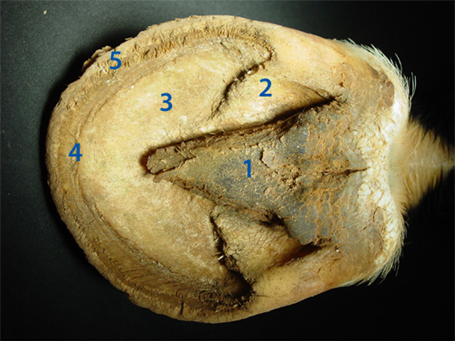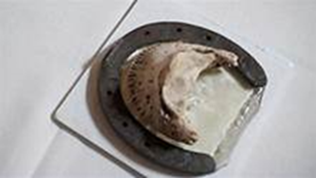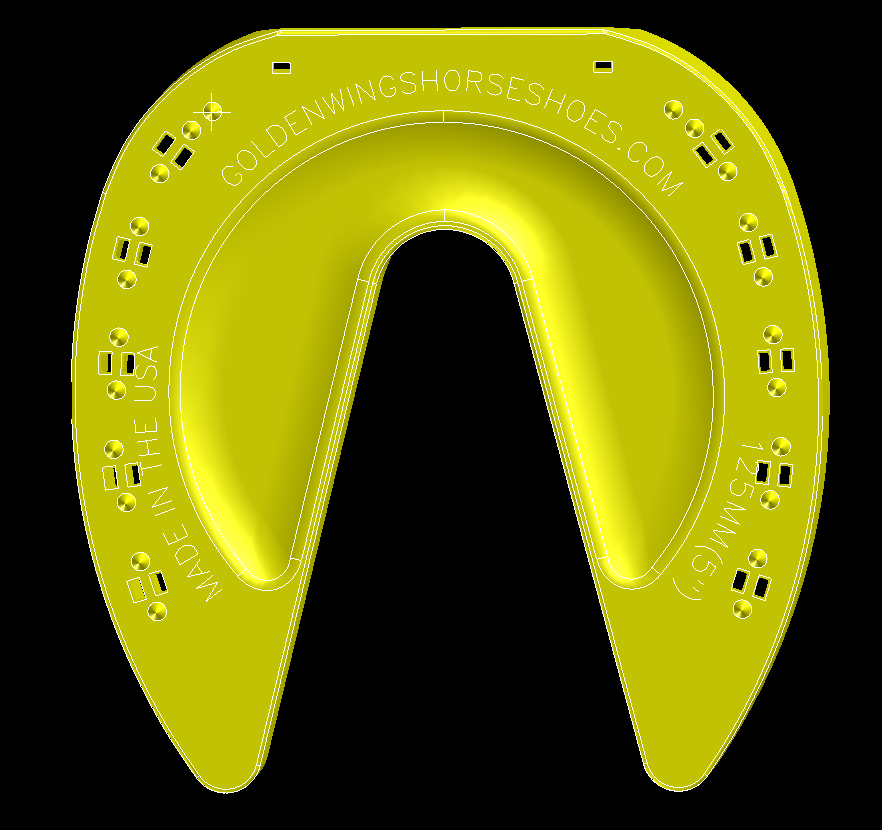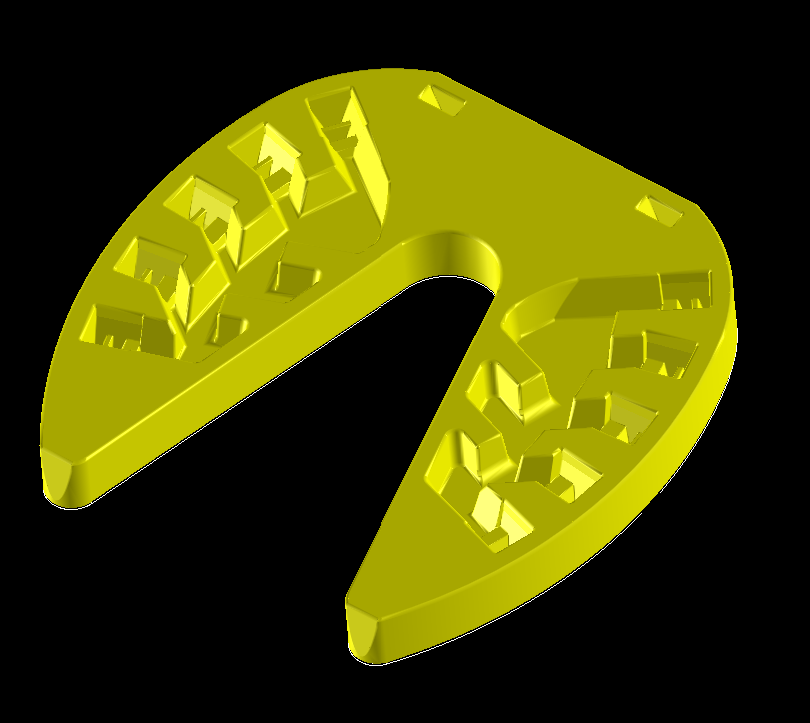Anatomy - The Hoof
The hoof contains over a dozen different structures. These include cartilage, bone, tendons, ligaments and other tissues. The coffin bone, also known as the pedal bone, is the major hoof bone. Under the coffin bone is the navicular bone that is surrounded by the navicular bursa. The main tendon in the hoof is the deep flexor tendon that connects to the bottom of the coffin bone. The digital cushion is a blood-filled structure in the middle of the hoof. It is flexible and assists the frog in shock absorption and blood flow. The digital cushion changes from use to a fibrous tissue. When these fibers break down or do not form properly, it may result in an oft misunderstood condition called Navicular Disease/Syndrome. GOLDEN WINGS HORSESHOES provide added protection.
Compare the Difference
GOLDEN WINGS HORSESHOES are designed to help stabilize the hoof and protect the coffin bone and its surrounding soft tissues.
The shoes help horses remain productive, avoid pain and have much longer careers.
In the first image you will see the entire hoof (1 – Frog, 2 – Bars, 3 – Sole, 4 – White Line, 5 -Walls) GOLDEN WINGS HORSESHOES provides protection to it all, NOT just the walls as most traditional horseshoes do.
GOLDEN WINGS HORSESHOES MAY ASSIST IN THE PREVENTION OF THE MYSTERIOUS NAVICULAR SYNDROME.

4 – White Line, 5 -Walls)

protection for the hoof structure.
Shown here, the coffin bone placed where
it would be exposed to trauma or injury.

Catcher’s Mitt

Golden wings Horseshoes are designed to Absorb Energy and Shock Like a Catcher’s Mitt & flex with each stride like the hoof capsule. Golden wings provide for additional shock absorption by providing a concave area directly above the tip of the coffin bone to flex and absorb shock like a catcher’s mitt. The concave area collects a thin layer of fine dirt to provide additional padding on contact.
This feature allows the sole to continue to perform as support, to be in active contact with the shoe and ground. The shoe acts as a protective pad for the sole and coffin bone with up to 14 mm thickness of flexible additional sole protection between the sole and the terrain acting to aid with prevention of stone bruising. Stone bruises are caused by a stone or sharp type of object, landings from high jumps, and excessive exposure to snow. A major symptom is lameness."
The sole of the hoof has white/yellow, sometimes grayish color. It covers the space from the walls (outer part of hoof) to the “frog” (rubbery center of hoof base). The sole has a deep layer that is wax-like, often called the “live sole.” Its surface comes in contact with the ground. The sole of wild horses is often thicker than domesticated horses, perhaps a feature that helps to prevent stone bruises and coffin bond injuries.
Kinesiology
As weight is placed on the hoof, pressure is transferred onto the digital cushion, then to the frog. The frog with the heel contacts with the ground first. The frog presses up on the digital cushion, flattening under the pressure and is forced outward within the hoof capsule. The frog pushes against the bars and the flexible hoof capsule. When the hoof is lifted, the frog and other flexible structures within the hoof quickly return to their normal position.
The horse’s legs act as levers in movement. The bones interact with the joints and move with coordination for the horse to move forward, back up, gallop, cut, trot and perform regular stride. Just as a human arm moves to lift weight that is in the hand, the horse’s legs move to lift the weight that is at the hoof. Human anatomy asks the elbow joint to decrease the angle of the levers of the bones in the forearm and upper arm. The amount of weight that is to be lifted is paramount in the ability of the human arm to function appropriately and without injury. The bones in a horse’s leg are the levers that must lift the weight of the hoof. When the weight of the hoof (and shoe) is reduced, the result is a more sound horse.
The front legs of a horse extend from the scapula (shoulder blade) to the navicular bone. Front leg joints include the elbow, knee, fetlock, pastern and coffin.
The front legs have 3 main muscles, all combined to be the triceps. They straighten the elbow.
GOLDEN WINGS HORSESHOES Addresses All of the Issues Regarding Movement in all Four Phases:
GOLDEN WINGS HORSESHOES are light in weight and thus reduce leverage. This allows for quicker strides and less stress on all supporting factors with the movement of the horse. There is up to 14 mm of protection for the hoof, including the sole. GOLDEN WINGS HORSESHOES are designed to serve as a cushion upon impact with similar material as the hoof itself, to flex with the foot rather than to bend or break.
GOLDEN WINGS HORSESHOES flex with the hoof and returns to its original shape. This prevents slipping for the next stride. Slipping may injure all the structures of the horse which can lead to lameness. GOLDEN WINGS HORSESHOES help to eliminate leverages and reduces the effect of long toe, low heel on all ligaments, tendons, muscles, bones and apparatus. The legs and hoofs perform most of the functions of absorbing impact and weight bearing as well as providing thrust.
Good movement should be symmetrical, straight, free and coordinated. All these depend on many factors including conformation, soundness, care and training, as well as terrain and footing. The conformations, proportions and length of the bones and muscles in the legs can impact movement in an individual horse. The angles of certain bones, especially in the hind leg, shoulders and pasterns also affect movement. The forelegs carry most of the weight, depending on speed and gait. At one point in the gallop, all the weight of the horse is resting on one front hoof.
In addition, with movement, the horse will land on its hoof and the angle of the levers in each individual horse will decide if the horse lands in a flat and level way. THE ONLY WAY TO CORRECT INAPPROPRIATE ANGLES IS IN THE TRIMMING. By using nature’s Golden Ratio (<-Click here), you then determine the correct angle for a specific horse as determined by the Golden Ratio or Divine Proportion."
GOLDEN WINGS HORSESHOES ARE PROBLEM SOLVERS!
